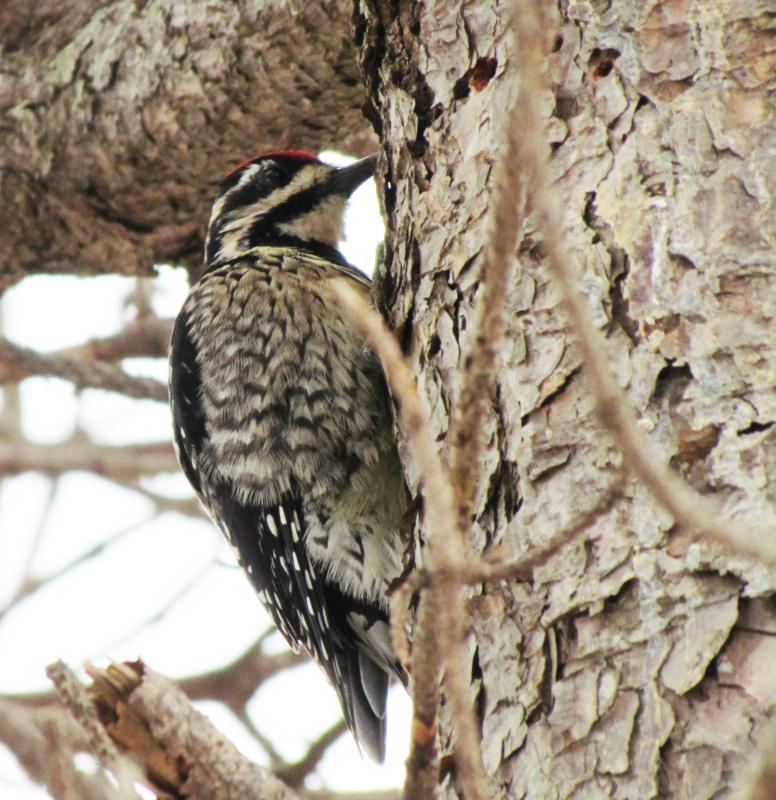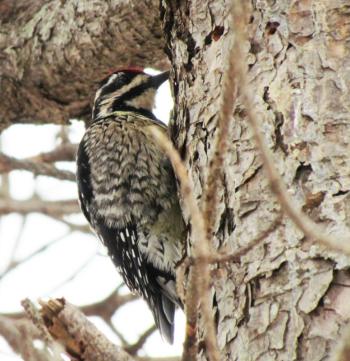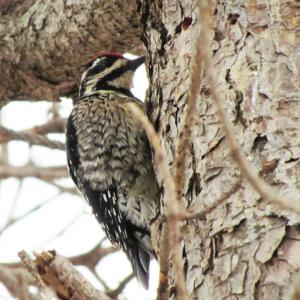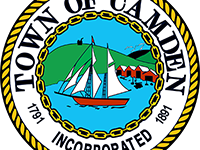Fall Bird Musings
 Yellow-bellied sapsuckers have been appearing around the authors' neighborhood during this fall migration, though not as many as were counted flying to the mainland from Cousin’s Island in Yarmouth in the fall of 2011 - that total reached 358! Yellow-bellied sapsucker photo courtesy of Jeff Wells
Yellow-bellied sapsuckers have been appearing around the authors' neighborhood during this fall migration, though not as many as were counted flying to the mainland from Cousin’s Island in Yarmouth in the fall of 2011 - that total reached 358! Yellow-bellied sapsucker photo courtesy of Jeff Wells
 White-throated sparrows are one of the more common October migrants across Maine. White-throated sparrow photo courtesy of Jeff Wells
White-throated sparrows are one of the more common October migrants across Maine. White-throated sparrow photo courtesy of Jeff Wells
 Yellow-bellied sapsuckers have been appearing around the authors' neighborhood during this fall migration, though not as many as were counted flying to the mainland from Cousin’s Island in Yarmouth in the fall of 2011 - that total reached 358! Yellow-bellied sapsucker photo courtesy of Jeff Wells
Yellow-bellied sapsuckers have been appearing around the authors' neighborhood during this fall migration, though not as many as were counted flying to the mainland from Cousin’s Island in Yarmouth in the fall of 2011 - that total reached 358! Yellow-bellied sapsucker photo courtesy of Jeff Wells
 White-throated sparrows are one of the more common October migrants across Maine. White-throated sparrow photo courtesy of Jeff Wells
White-throated sparrows are one of the more common October migrants across Maine. White-throated sparrow photo courtesy of Jeff Wells
The distinctive buzz and tiny, high-note sputters of the juncos are now everywhere when we walk the neighborhood. That and the high “seet” notes of the white-throated sparrows that emanate from every bush at dawn are clear signals that we are in the latter half of the fall bird migration season.
Listening at night, we also hear mostly those same white-throated sparrow “seet” notes as the birds flow south in night migration.
Yellow-bellied sapsuckers have been appearing here and there around town on our walks as well. They too tend to be later-fall migrants. Out on Monhegan Island, there have been several days in October this year during which more than 30 have been counted in a single day. That’s a lot of sapsuckers but, believe it or not, 358 were counted over a couple of hours flying back to the mainland from Cousin’s Island in Yarmouth on the morning of October 6, 2011. Now, that’s really a lot of sapsuckers!
Another migratory woodpecker, the northern flicker, has been counted in even larger numbers. Imagine, if you can, the more than 2,000 flickers that an observer carefully counted at the Cousin’s Island crossing on the morning of September 24, 2022. Impressive!
October has also brought the special geese species back, especially in northern Maine where they have become regular, if still rare. Pink-footed goose, greater white-fronted goose, and cackling goose have been seen up in Aroostook County. Several more cackling geese have been seen in southern Maine, and there was even a Ross’s goose found along the Kennebec River in Benton.
While these later-fall arrivals are showing up, there are still quite a few birds of summer that are lingering (or at least a few individuals are). There seem to be a smattering of gray catbirds, though we haven’t heard that distinctive whining call in our yard for about ten days. One or two of a number of warblers that should be in the Caribbean or Central or South America are hanging on here and there, mostly in southern Maine. Someone even had a late red-eyed vireo over the last few days.
Faithful readers will remember that we were enjoying migrant birds in Florida just last weekend. Some of the same shorebird species we saw on those white sand beaches near St. Petersburg can still be found in and around Maine’s beaches—sanderlings, red knots, semipalmated plovers, and black-bellied plovers among them. A glance at eBird shows that in all four of these species, there are individual birds stretched out from southern Canada and Maine all the way south to southern South America at the moment. When cooler weather eventually prevails, those birds along the northern edge will retract and shrink the range southward.
Has anyone seen the first American tree sparrow of the season yet? That’s one of the latest migrants to arrive—redpolls, too, but one was amazingly documented (photographed) super early this year in September on Monhegan Island.
Enjoy birding this fall!
Jeffrey V. Wells, Ph.D., is a Fellow of the Cornell Lab of Ornithology and Vice President of Boreal Conservation for National Audubon. Dr. Wells is one of the nation's leading bird experts and conservation biologists. He is a coauthor of the seminal “Birds of Maine” book and author of the “Birder’s Conservation Handbook.” His grandfather, the late John Chase, was a columnist for the Boothbay Register for many years. Allison Childs Wells, formerly of the Cornell Lab of Ornithology, is a senior director at the Natural Resources Council of Maine, a nonprofit membership organization working statewide to protect the nature of Maine. Both are widely published natural history writers and are the authors of the popular books, “Maine’s Favorite Birds” (Down East Books) and “Birds of Aruba, Bonaire, and Curaçao: A Site and Field Guide,” (Cornell University Press).




























